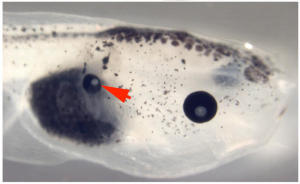This is a first step to cracking the bioelectric code
For the first time, scientists have altered natural bioelectrical communication among cells to directly specify the type of new organ to be created at a particular location within a vertebrate organism. Using genetic manipulation of membrane voltage in Xenopus (frog) embryos, biologists at Tufts University’s School of Arts and Sciences were able to cause tadpoles to grow eyes outside of the head area.
The researchers achieved most surprising results when they manipulated membrane voltage of cells in the tadpole’s back and tail, well outside of where the eyes could normally form. “The hypothesis is that for every structure in the body there is a specific membrane voltage range that drives organogenesis,” said Pai. “These were cells in regions that were never thought to be able to form eyes. This suggests that cells from anywhere in the body can be driven to form an eye.”
To do this, they changed the voltage gradient of cells in the tadpoles’ back and tail to match that of normal eye cells. The eye-specific gradient drove the cells in the back and tail — which would normally develop into other organs — to develop into eyes.
These findings break new ground in the field of biomedicine because they identify an entirely new control mechanism that can be capitalized upon to induce the formation of complex organs for transplantation or regenerative medicine applications, according to Michael Levin, Ph.D., professor of biology and director of the Center for Regenerative and Developmental Biology at Tufts University’s School of Arts and Sciences. Levin is senior and corresponding author on the work published in the journal “Development.” online December 7 2011, in advance of print.
“These results reveal a new regulator of eye formation during development, and suggest novel approaches for the detection and repair of birth defects affecting the visual system,” he said. “Aside from the regenerative medicine applications of this new technique for eyes, this is a first step to cracking the bioelectric code.”
Tufts post-doctoral fellow Vaibhav P. Pai Ph.D., is first author of the paper, entitled “Transmembrane Voltage Potential Controls Embryonic Eye Patterning in Xenopus laevis.” .
Signals Turn On Eye Genes
From the outset of their research, the Tufts’ biologists wanted to understand how cells use natural electrical signals to communicate in their task of creating and placing body organs. In recent research, Tufts biologist Dany S. Adams showed that bioelectrical signals are necessary for normal face formation in the Xenopus (frog) embryos. In the current set of experiments, the Levin lab identified and marked hyperpolarized (more negatively charged) cell clusters located in the head region of the frog embryo.
They found that these cells expressed genes that are involved in building the eye called Eye Field Transcription Factors (EFTFs). Sectioning of the embryo through the developed eye and analyzing the eye regions under fluorescence microscopy showed that the hyperpolarized cells contributed to development of the lens and retina. The researchers hypothesized that these cells turned on genes that are necessary for building the eye.
Bookmark this page for “bioelectrical signals” and check back regularly as these articles update on a very frequent basis. The view is set to “news”. Try clicking on “video” and “2” for more articles.








